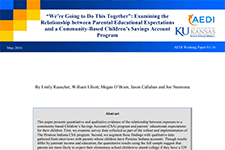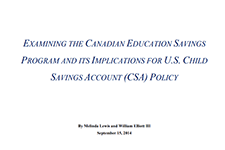Discover financial empowerment resources
Discover financial empowerment resources
This is a brief on the cost of financially insecure families to Chicago, in terms of cost of eviction and unpaid bills. The financial health of cities depends on financially secure residents. When families have little to no savings and experience a disruption in their income or expenses, bills may...
In this paper, we examine the relationship between children’s small-dollar savings accounts and college enrollment and graduation. We find that LMI children may be more likely to enroll in and graduate from college when they have small-dollar savings accounts with money designated for school. An...
This paper presents quantitative and qualitative evidence of the relationship between exposure to a community-based Children’s Savings Account (CSA) program and parents’ educational expectations for their children. First, we examine survey data collected as part of the rollout and...

This report analyzes the Canadian experience with education savings programs, as the US moves towards more comprehensive Children's Savings Account...

In this paper it is suggested that Children’s Savings Accounts (CSAs) are an investment that may embody the meritocratic values that Americans have for so long professed, values that demand that effort and ability decide why one person succeeds and another fails. More specifically, it is...
Reimagining financial aid to include asset accumulation for those currently disadvantaged has the potential to meet one of our most critical challenges: equipping enough students to succeed in college education to power future societal economic prosperity, at a cost individual students and our...
In most cases, allowable uses of CSAs are limited to higher education initially, with some allowance for homeownership, entrepreneurship, or other capital investment later. Although, more recent proposals for CSAs also include tiered structures so that children could access some savings while still...
Addressing the educational challenges facing disadvantaged children will require innovations that can create greater equality of opportunity, such that their innate talents and academic effort translate into meaningful access to college. Evidence points to differences in asset accumulation a part...
This paper has two main goals. First, we provide a review of 38 studies on the relationship between assets and children’s educational attainment. Second, we discuss implications for Child Development Accounts (CDAs) policies. CDAs have been proposed as a potentially novel and promising asset...
